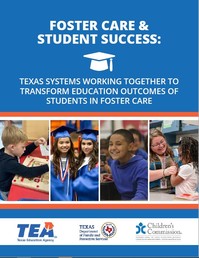Back-to-School Checklist
 |
|
- Ensure the name and contact information for your LEA Foster Care Liaison is accurate and up-to-date (see section below for more information.)
- Provide training to all staff who will be assisting students in foster care.
- Immediately enroll students in foster care! Reminder: Students with missing records may be provisionally enrolled and have 30 days to provide all of the information required for enrollment.
- Ensure the receipt of the 2085 and 2085E forms and maintain confidentiality.
- Work with your school nutrition program to verify eligibility and expedite nutrition benefits for students in foster care.
- Obtain Pre-K verification for students in foster care.
- Ensure students are coded as At-Risk (for compensatory education purposes) and receive all services and supports available.
|

Each school district and open-enrollment charter school in Texas is required to appoint at least one employee to act as an LEA Foster Care Liaison. Both districts and open-enrollment charter schools must keep their LEA Foster Care Liaison's name and contact information updated in AskTED. It is important to take time at the beginning of each school year to ensure your LEA Foster Care Liaison’s contact information is up to date.
|
How to update information in AskTED:
Districts
Provide the liaison information to your district’s AskTED administrator. Include the liaison’s name, email address, and phone and fax numbers.
Charter Schools
Submit the liaison information to the TEA Charter School Division directly via (512) 463-9575 or CharterSchools@tea.texas.gov. Include the liaison’s name, email address, and phone and fax numbers. This information will be added to the AskTED directory for you.
Find more information on the Foster Care Points of Contact page.
PEIMS Coding and Documents
A new school year means identifying new students and updating student coding from the previous year. Schools must enter a Foster Care Indicator Code in PEIMS for students who are currently in the conservatorship of DFPS. Pre-kindergarten students must also be coded if they were previously in DFPS conservatorship. Students identified as in foster care must also be coded with PEIMS at-risk indicator code #11.
Effective September 1, 2021: Schools must now capture in PEIMS a pre-kindergarten student who is currently in or was formerly in foster care in another state. These students must be coded under Foster Care Indicator code #3 (Code table C196). This new PEIMS code aligns with the expansion of Pre-K eligibility for students from other state foster care systems who reside in Texas (see the next section).
A student’s foster care status coded in PEIMS remains for the entire year, regardless of whether the student stays in or exits foster care. The Foster Care Indicator code does not carry over from year to year. Schools must have a process in place to verify the foster care status of students that remain enrolled from one year to the next.
The following documents may be used to determine if a student is in DFPS conservatorship:

1. DFPS Placement Authorization Form 2085*,
2. DFPS Designation of Education Decision-Maker Form 2085-E, or
3. A court order.
*Any form in the 2085 series is acceptable.
|
Note: Students from other state foster care systems are currently not flagged for foster care status in PEIMS (except for pre-kindergarten students under code #3, as noted above). However, they are eligible for school nutrition and Every Student Succeeds Act (ESSA) benefits. LEAs should provide support for these students, even though they are not captured in PEIMS.

House Bill 725 expanded free Pre-K eligibility for students from other state foster care systems who reside in Texas. This applies to students who are currently in or were formerly in another state’s foster care system. This change makes it so that all students currently or formerly in foster care (regardless of the state where the child was in foster care) are eligible for Pre-K in Texas. See the section above for important information on PEIMS coding for these students.
Note: Students in or formerly in Texas DFPS Managing Conservatorship are issued a letter that is provided to the school for Pre-K eligibility. This letter is Texas specific and will not be provided to verify a student’s child welfare status from another state. To verify eligibility, schools can request a redacted court order or other official paperwork from the state or county child welfare agency which states that the student is in or was previously in their custody.
|

Is there guidance for students in foster care who receive special education services?
|

In the past, it was recommended not to place Form 2085 or foster care forms in the student’s cumulative folder. Is this the continued recommendation?
|

The 2085 should be stored confidentiality. It is imperative that the form is in a secure location. This may or may not be the cumulative folder based on your district and/or campus processes and procedures concerning the cumulative folder.
|

Who can I contact if I have a foster care concern?
|
See the Foster Care FAQ for more frequently asked questions!
19 TAC Chapter 89. Adaptations for Special Populations. Subchapter FF. Commissioner's Rules Concerning Transition Assistance for Highly Mobile Students Who Are Homeless or in Substitute Care
Effective Date: March 30, 2020.
LEAs must develop systems to ease transitions of students who are homeless or in foster care during the first two weeks of enrollment at a new school. The system must include student welcome packets, introduction to school processes and programs, qualification of nutrition benefits upon enrollment, and enrollment conferences. The Highly Mobile and At-Risk Student Programs Division has an upcoming training series to Help LEAs with understanding these requirements. Tools to assist LEAs with implementation will also be available soon!
Transition Assistance Training Series
See 19 TAC Chapter 89, Subchapter FF for more information.
Self-Assessment Tool

The Highly Mobile & At-Risk Student Programs Division is developing a self-assessment tool for LEAs to review implementation of services, programs, and supports for highly mobile (Foster Care, McKinney-Vento, Military-Connected) students. The self-assessment was created for LEAs as a part of the Results Driven Accountability System, which now includes highly mobile students. TEA will provide training for LEAs on utilizing the self-assessment in the coming months. Be on the lookout for the official release in the Spring of 2022.
|
Foster Care Guide Update
 |
|
Our team is working with the Texas Department of Family and Protective Services (DFPS) and the Children’s Commission to release an updated version of the Foster Care and Student Success Resource Guide.
This version will include new laws, resources, and key updates, PLUS two new chapters covering the Every Student Succeeds Act and Trauma-Informed Education. The updated guide will be downloadable from the Foster Care & Student Success webpage in the coming months.
|
New TEA Foster Care Contact
LaTrenda Watson recently joined the Highly Mobile and At-Risk team as the Highly Mobile and At-Risk State Coordinator. She will be the point of contact for Foster Care, Pregnancy Related Services, and Dropout Prevention programs. For any questions, please contact the corresponding program emails:
|